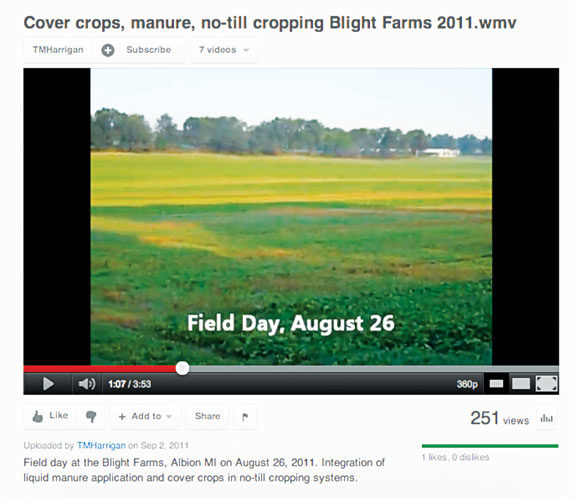Cropping systems that reduce tillage intensity, incorporate cover crops when practical and make efficient use of manure or other organic inputs in the crop rotation can build soil quality and productivity and protect the environment in many ways.
Low-disturbance tillage and soil conservation practices that stabilize soil will keep nutrients in the root zone and protect surface waters from runoff and sedimentation.
Cover crops trap and recycle crop nutrients and filter contaminants in runoff. They also increase water infiltration compared to soil without cover crops.
What is soil quality?
Soil quality brings together the physical, chemical and biological characteristics that enhance the soil’s ability to produce quality crops and protect the environment.
Some of the physical characteristics of good-quality soil are an optimal structure for stand establishment and crop/root growth, stable aggregate structure and the ability to provide for water infiltration, drainage and aeration.
Some of the biological factors are the ability to mobilize nutrients when needed for crop growth yet minimize leaching loss and the ability to maintain a balance of pests and pathogens.
Finally, some of the chemical factors indicating good soil quality are the ability to supply the nutrients needed for crop growth and the ability to retain nutrients in the upper soil layer.
If cropping systems are managed to create conditions that build and protect soil quality, the soil will be more resilient and productive.
If the soil is overwhelmed by excessive tillage, traffic or erosion from wind and water, loss of nutrients and organic matter or crop rotations that upset the biological balance of pests, pathogens and soil microbes, efficient and profitable crop production will be a challenge.
Create a comfortable seed environment
A goal in efficient crop production is to create an optimal seed environment. An optimal environment provides the right soil temperature and moisture and allows seed-to-soil contact for rapid germination and emergence, maintains good soil tilth for root growth and drainage, and conserves moisture for plant use.
Managing the farming system for soil quality can be a challenge, yet many producers are changing their farming systems with soil quality in mind.
It is important to understand that there is no single tillage tool, crop or management practice that will solve a soil quality problem.
Building soil quality means managing the entire farming system – tillage and planting practices, cropping systems and rotations, harvest and traffic patterns.
Look for opportunities to reduce tillage frequency and intensity and use cover crops and manure to protect the environment, recycle nutrients and build stable soil aggregates.
Managing the farming system
Tillage operations are important in many farming systems to prepare a seedbed; control weeds, insects and disease; manage soil compaction and crop residue; and incorporate soil amendments, so it may be difficult to reduce tillage operations in some cases.
But you can’t simply till your way out of a soil quality problem. Tillage can degrade soil quality by breaking down aggregate structure.
Stable soil aggregates are created slowly by natural processes, but they can break down quickly under the action of tillage tools. Look for opportunities to combine field operations and reduce tillage intensity when managing for soil quality.
Soil compaction is the loss of pore space in the soil. Pore space is needed for drainage and oxygen exchange, root growth and efficient nutrient use.
Tillage and traffic are the primary cause of most soil compaction. Soil symptoms of compaction are crusting, a cloddy seedbed, standing water and an absence of plant roots in the soil.
Common plant symptoms are variable emergence, variable size, wilting and yield decline.
Soil compaction can occur in all soils – including mucks and sandy soils. It can be shallow (in the normal tillage zone), deep (below the normal tillage zone) and is most likely in poorly drained, fine-textured soils.
Machinery can damage soil from compression, shear and vibration. Generally, 70 to 90 percent of tire sinkage and increase in soil bulk density occurs on the first pass. Repetitive traffic drives compaction deeper.
Excessive tillage contributes to soil compaction, but strategic tillage is a fast and effective way to reduce compaction.
Tillage can increase pore space in the root zone and improve infiltration and drainage, but tillage-induced pores are not structurally stable and do not effectively resist traffic-induced soil compaction.
After years of reduced tillage, soil is more resilient and resistant to compaction from traffic, but it can be damaged quickly by working or driving on wet soil.
Natural processes alleviate compaction
In the long term, soil compaction can be reduced by natural processes that cause the soil to shrink and swell, such as wetting and drying, and freezing and thawing.
Root growth helps fracture compacted soil. Plant roots and soil microbes produce exudates that form natural glue in forming stable soil aggregates. Earthworm activity inverts soil and creates channels for water infiltration and root growth.
Add organic inputs with manure and cover crops
Reducing tillage intensity is important, but you can’t simply no-till your way out of a soil quality problem. To have an impact in a reasonable period of time you also need additional organic inputs, such as crop residue, manure and cover crops.
Cover crops protect the surface from wind and water erosion, recycle plant nutrients, improve water infiltration and add organic carbon to the soil.
Manure provides many of the same benefits. Both manure and cover crops increase organic matter and water- holding capacity, improve aggregate stability and water infiltration and decrease evaporation and soil bulk density.
Putting it all together
Michigan State University Extension is cooperating with the folks at Blight Farms near Albion, Bloom Dairy near Coldwater and Baker Lad’s Farm near Adrian to demonstrate and evaluate efficient and effective ways to incorporate manure and cover crops in modern cropping systems.
Some of the seeding options include broadcasting or no-till drilling cover crops with a manure application on the same day or later in the season over a vegetative cover or slurry seeding the cover crops by placing the seed in the manure slurry and preparing a seedbed with low-disturbance tillage.
At Blight Farms, we have seeded cereal rye, annual ryegrass, forage turnips, oats and oilseed radish with swine manure after wheat harvest with excellent results.
At Bloom Dairy and Baker Lad’s Farm we have seeded cereal rye alone or with oilseed radish with dairy manure as a winter vegetative cover and as spring-chopped forage. Again, we had excellent results at each location.
You can watch a short video of the seeding process and the resulting cover crops by clicking on one of the following links:
• Blight Farms, 2011 – http://bit.ly/BlightFarms11Seeding
• Blight Farms, 2010 – http://bit.ly/BlightFarms10Seeding
• Bloom Dairy, 2010 – http://bit.ly/BloomDairy10Seeding FG
—Excerpts from Michigan State University Extension News for Agriculture
PHOTO:
Top Right: You can watch a short video of the seeding process and the resulting cover crops by following one of the links at the end of this article. Screen capture courtesy of YouTube.













